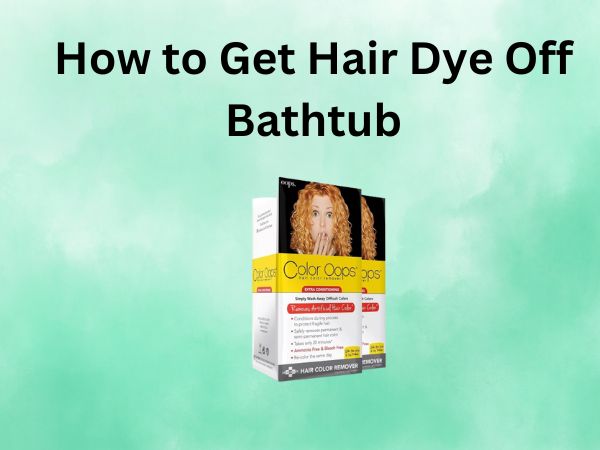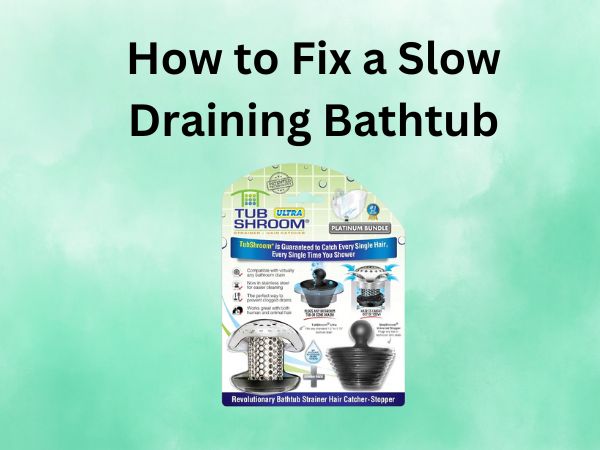How to Get Hair Dye Off Bathtub [Complete Removal Guide]
We’ve all been there – that moment of panic when you finish dyeing your hair and turn around to see colorful splatters all over your pristine bathtub. Whether it’s bold purple, vibrant red, or classic black, hair dye seems determined to leave its mark on your bathroom fixtures. But don’t worry! I’ve got you covered with this comprehensive guide to getting those stubborn dye stains off your bathtub without damaging the surface.
Table of Contents
Understanding Hair Dye Stains
Why Hair Dye Stains Bathtubs
Hair dye is designed to penetrate and permanently color hair fibers – which unfortunately means it’s equally determined to stick to your bathtub. The chemical composition of hair dye includes molecules that actively bind to surfaces, creating those stubborn stains we dread. Permanent dyes contain developer and ammonia that open up surfaces at a microscopic level, allowing the color to penetrate deeply.
“The longer a dye sits on your bathtub surface, the more difficult it becomes to remove,” explains the situation perfectly. The pigments in hair dye begin setting almost immediately upon contact with your tub’s surface, creating a chemical bond that strengthens over time.
Common Types of Bathtub Materials and How They React to Dye
Different bathtub materials interact with hair dye in unique ways:
- Porcelain and Ceramic: These surfaces are somewhat resistant but can still absorb dye, especially if there are any tiny cracks or worn areas in the glaze.
- Acrylic: More prone to staining as the material is slightly porous. Dye can penetrate quickly, so immediate action is crucial.
- Fiberglass: Similar to acrylic, fiberglass can easily absorb dye, creating challenging stains.
- Enamel: While generally durable, enamel can absorb dye into any chips or scratches.
Understanding your bathtub material is essential because it determines which cleaning methods will be most effective and which might damage your tub.
Immediate Actions to Prevent Setting
Quick Response Steps
The golden rule with hair dye spills is simple: act fast! The sooner you address a hair dye stain, the better your chances of complete removal. Fresh dye hasn’t had time to bond with your bathtub surface, making it significantly easier to clean.
Rinsing with Hot Water
As soon as you notice dye splatter, grab your showerhead or a cup and flush the area with hot water. The heat helps keep the dye molecules active and less likely to bond permanently. Don’t use scalding water – you don’t want to risk burning yourself while cleaning.
Keep the water running over the stained area for at least 30-60 seconds to dilute and remove as much of the dye as possible before it sets.
Wiping While Still Wet
While the dye is still wet, use paper towels or an old cloth to blot and wipe away as much as possible. Don’t rub aggressively, as this might spread the dye or push it deeper into porous surfaces. Instead, gently blot to lift the dye away from the surface.
Have you noticed how much easier it is to remove dye when it’s fresh? That’s because the binding agents haven’t fully activated yet, giving you a critical window for effective cleanup.
Household Remedies for Hair Dye Removal
Baking Soda Solutions
Baking soda is my go-to first line of defense against hair dye stains. This gentle abrasive works wonders without damaging most bathtub surfaces.
To create an effective baking soda paste:
- Mix baking soda with a small amount of water until it forms a thick, spreadable paste
- Apply directly to the stained areas
- Let it sit for 10-15 minutes to work its magic
- Scrub gently with a non-abrasive sponge using circular motions
- Rinse thoroughly with warm water
For extra stubborn stains, you can add a few drops of dish soap to your baking soda paste to help break down the dye’s oils.
Vinegar Methods
White vinegar is another powerful ally in your fight against hair dye stains. The acidity in vinegar helps break down the dye molecules, making them easier to remove.
Try this effective vinegar solution:
- Create a 50/50 mixture of white vinegar and warm water
- Apply directly to the stains using a spray bottle or soaked cloth
- Allow it to sit for 15-20 minutes
- Scrub with a soft brush or sponge
- Rinse thoroughly
For particularly stubborn stains, you can heat the vinegar solution slightly before applying – but make sure it’s not too hot to touch safely.
Lemon Juice Techniques
Like vinegar, lemon juice contains natural acids that break down hair dye. Plus, it leaves your bathroom smelling fresh rather than like a salad dressing!
The most effective lemon juice method:
- Squeeze fresh lemon juice directly onto the stain
- Sprinkle a small amount of table salt over the juice to create a gentle abrasive
- Let sit for 10 minutes
- Scrub with a soft brush
- Rinse completely
Have you ever noticed how lemon cuts through grease on your dishes? It works similarly on the compounds in hair dye, breaking them down at a molecular level.
Hydrogen Peroxide Applications
Hydrogen peroxide is particularly effective for lighter colored bathtubs, as it has mild bleaching properties along with its stain-fighting abilities.
To use hydrogen peroxide safely:
- Apply 3% hydrogen peroxide directly to the stain
- Cover with a damp white cloth to prevent evaporation
- Let it work for 30 minutes
- Wipe and rinse thoroughly
Remember that hydrogen peroxide can have a mild bleaching effect, so test it on an inconspicuous area first if you’re concerned about discoloration.
Commercial Products That Remove Hair Dye Stains
Bathroom Cleaners Effective for Dye
Not all bathroom cleaners are created equal when it comes to tackling hair dye. Look for products that specifically mention “stain removal” capabilities.
Some widely available bathroom cleaners that work well include:
- Bar Keepers Friend
- Comet Bathroom Cleaner
- Lysol Toilet Bowl Cleaner (yes, it works on bathtubs too!)
When using commercial cleaners, always follow the manufacturer’s instructions and ensure proper ventilation in your bathroom.
Specialized Stain Removers
For particularly stubborn dye stains, specialized products might be your best bet:
- “Dyex” hair color remover
- “Stain Devils” for makeup and dye
- “Goof Off” stain remover
Comparison of Top Products
| Product | Best For | Caution |
| Bar Keepers Friend | Porcelain, ceramic | Can scratch acrylic if used too aggressively |
| Dyex | All surfaces | More expensive than household options |
| Magic Eraser | Quick touch-ups | Can wear down with excessive scrubbing |
| Goof Off | Extremely stubborn stains | Strong fumes require ventilation |
When choosing a commercial product, consider your specific bathtub material and the severity of the stain.
Advanced Methods for Stubborn Stains
Acetone-Based Solutions
For those truly stubborn stains that resist other methods, acetone (nail polish remover) can be effective – but use with caution.
To use acetone safely:
- Apply a small amount to a cotton ball
- Dab (don’t rub) the stained area
- Wait 5-10 minutes
- Rinse thoroughly
- Clean with regular bathroom cleaner afterward
Important: Never use acetone on acrylic or fiberglass tubs as it can damage these surfaces! It’s best reserved for porcelain or ceramic.
Magic Eraser Techniques
Magic Erasers can be remarkably effective against hair dye stains:
- Wet the Magic Eraser with water
- Gently rub the stained area using light pressure
- Rinse the residue away
- Repeat if necessary
The micro-abrasive structure of Magic Erasers works like extremely fine sandpaper, lifting stains without harsh chemicals. Isn’t it amazing how this simple sponge can do what expensive cleaners sometimes can’t?
Bleach (When Appropriate)
Bleach should be your last resort, but it can be effective for white or light-colored bathtubs:
- Dilute 1 part bleach with 10 parts water
- Apply to the stain with a cloth
- Let sit for no more than 10 minutes
- Rinse thoroughly and ventilate the area
Never mix bleach with other cleaning products, especially ammonia or vinegar, as this can create dangerous toxic fumes. And always wear gloves when working with bleach to protect your skin.
Preventative Measures for Future Dye Sessions
Protective Coverings
The best way to deal with hair dye stains is to prevent them in the first place! Before your next coloring session:
- Line your bathtub with old towels you don’t mind staining
- Use plastic wrap to cover vulnerable areas
- Consider purchasing a hair dye mat specifically designed for this purpose
These simple preparations can save you hours of scrubbing later.
Pre-Treatment Options
Another smart preventative approach is to pre-treat your bathtub before dyeing:
- Apply a thin layer of petroleum jelly to areas most likely to receive splatter
- Spray surfaces with a light coating of shower spray
- Keep a spray bottle of undiluted white vinegar nearby for immediate treatment of any drops
Think of these pre-treatments like applying painter’s tape before painting walls – a small effort upfront saves significant cleanup later.
FAQs About Hair Dye Stain Removal
1. Can hair dye permanently stain my bathtub?
If left untreated for extended periods, hair dye can indeed create permanent stains, especially on porous surfaces like acrylic or fiberglass. However, with prompt and appropriate treatment, even “permanent” dye can usually be removed or significantly reduced.
2. Is it safe to use bleach on all bathtub types?
No. Bleach should only be used on white porcelain or ceramic tubs, and even then as a last resort. Never use bleach on colored tubs, acrylic, fiberglass, or enamel, as it can cause discoloration or damage to these surfaces.
3. How can I tell what material my bathtub is made from?
Porcelain and ceramic tubs feel cold to the touch and make a solid sound when tapped. Acrylic and fiberglass feel warmer and make a hollow sound when tapped. When in doubt, check your home documentation or consult with a plumbing professional before using harsh chemicals.
4. Will these methods work on hair dye that has been dried for weeks?
Old, set-in stains are more challenging but not impossible to remove. Start with the hydrogen peroxide method, letting it sit longer (up to an hour), then progress to more potent options like specialized stain removers if needed. Multiple applications may be necessary.
5. How can I remove hair dye stains from bathroom tiles and grout?
For bathroom tiles, most of the methods described for bathtubs will work effectively. For grout, which is more porous, try a paste of baking soda and hydrogen peroxide, allowing it to sit for 15-20 minutes before scrubbing with an old toothbrush. For stubborn grout stains, a commercial grout cleaner or whitener may be necessary.
Conclusion
Getting hair dye off your bathtub doesn’t have to be a nightmare. By acting quickly, using the right products for your specific bathtub material, and employing effective techniques, you can restore your tub to its former glory. Remember that gentler methods should always be tried first before progressing to more aggressive options.
Prevention remains your best strategy – taking a few minutes to prepare your bathroom before coloring can save you significant time and frustration afterward. So the next time you decide to refresh your hair color, you can focus on enjoying your new look rather than panicking about bathtub stains.
Have you dealt with hair dye stains before? Which methods worked best for you? Everyone’s experience is different, and sharing tips helps build our collective knowledge for tackling this colorful challenge!



